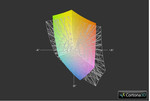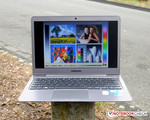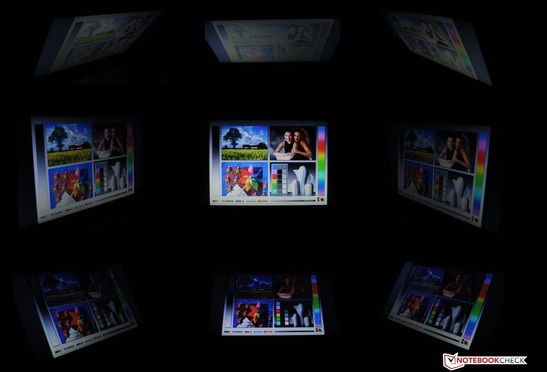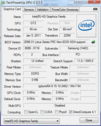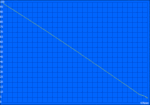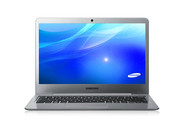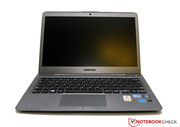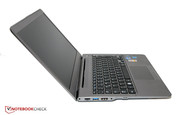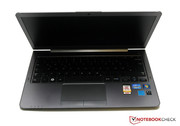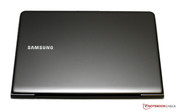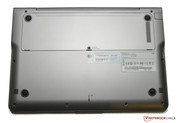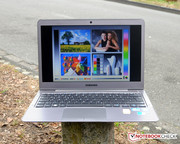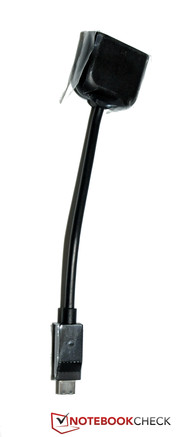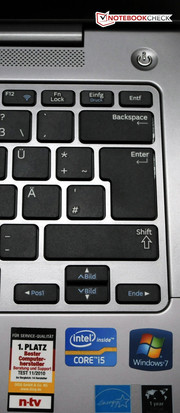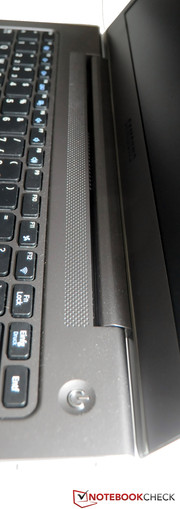Review Samsung 530U3B-A01DE Notebook
"Ultrabook" was the keyword for many notebook manufacturers at the last CeBit in Hanover. The new device class brings a breath of fresh air to the notebook market, and almost every manufacturer is trying to establish itself in the innovative category. Samsung's Series 5 currently has two models that meet Intel's criteria on an ultrabook. The notebooks have a 13.3 inch, matt screen. Unlike most ultrabooks, they aren't equipped with a big SSD. Instead, they have a small 16 GB flash memory (Express Cache) in combination with a 500 GB HDD at a speed of 5400 revolutions per minute. The ultrabook has a slim height of 17.6 mm and roughly weighs 1450 grams. Thus, nothing stands in the way of using the Samsung ultrabook on the move.
The model 530U3B is available in the versions A01 and A02. The difference between both models is only that the version A01 is configured with an Intel Core i5-2467M (1.6 GHz) and has a 4 GB DDR3 working memory. The more expensive A02 model has an 8 GB DDR3 working memory and the somewhat faster Intel Core i7-2637M (1.7 GHz) CPU. As to the graphics card, both models use the processor integrated Intel HD Graphics 3000.
We summarized the results of the slim and light Samsung 530U3B's performance in the following review. In this review, we will limit ourselves to the version 530U3B-A01 that was sold at a street price of less than EUR 750 at the time of the testing.
Case
The ultrabook of Samsung's Series 5 appears in elegant, silver looks. Samsung relies on aluminum for its notebook, whereas fiber glass is used for the bottom. The maximum height of just only 17.6 mm, as well as the weight of roughly 1.45 kilograms is rather low. However, other current ultrabooks, such as the Toshiba Portégé Z830 that only weighs 1.1 kilograms, can beat this.
But what about the case's stability? The case can be twisted to a part and also allows stronger denting selectively. This is noticed especially in the area above the keyboard and below the display hinges. The surface here yields considerably under pressure. This leads us to the next weak point: the display hinges. They are made of a big, elongated element. However, it only does its job unsatisfactorily in the case of our test device. The screen teeters extremely after adjustments. This can lead to restrictions during mobile use in cases of jerking movements, like on the bus or train.
The bottom only allows accessing the working memory and the installed 500 GB hard disk. The battery is unfortunately built-in permanently so that it's impossible for the normal user to replace it on his own devices.
Although other ultrabooks, such as the Asus Zenbook UX31 or the ultrabook ancestor Apple MacBook Air, have a higher stability due to the aluminum unibody design, there is no need for worries about the Samsung 530U3B. Basically, it's only the display hinge that leaves a slightly bittersweet aftertaste.
Connectivity
The compact build of ultrabooks calls for compromises, also partly in the connectivity. Thus, installing an optical drive can't be considered. Moreover, tricks were used for building in a few ports, such as the LAN port or VGA port. So, the LAN port, which is more often than not omitted in ultrabooks, can be opened to the right size via a movable element. A VGA port would also be too bulky for the ultrabook. Therefore, the (fortunately) included adapter has to be connected to the corresponding monitor port in order to obtain a VGA port.
Samsung also installs a fast USB 3.0 port, as well as two of the older USB versions in its 530U3B model. The user even has a modern HDMI socket available. All interfaces are located on the left and right rear sides of the ultrabook. Compared to other ultrabooks, the Samsung 530U3B has a diverse supply of interfaces. For example, Dell only installs one of each USB version into its XPS 13, just like the ultrabook HP Folio 13 or Lenovo U300s model offer. There is no LAN socket or a HDMI / VGA port in the Dell XPS 13. In return, the still rarely used MiniDisplay port is present in this device.
Communication
Samsung's ultrabook offers three options to communicate with other devices. First, the user can use the conventional LAN port for a wired connection. Second, there is the option of a wireless connection via the wifi module Intel Centrino Advanced-N 6230 (abgn). This wifi module supports Intel's Wireless Display technology, which makes video cables unnecessary providing that the corresponding image reproducing devices are available. And finally, the ultrabook also offers Bluetooth in its latest version, 3.0 +HS. The ultrabooks of the Series 5 don't have a UMTS module. External devices would have to be used for this.
Accessories
In addition to the laptop and the power adapter, the buyer will find manuals, a recovery CD and the VGA adapter in the product's box.
Warranty
Samsung grants a 24 month warranty with an on-site pick-up service on its Samsung 530U3B. The warranty can be extended to 36 months or 48 months for a surcharge, according to your needs. The warranty extension has to be claimed within 90 days after the ultrabook's date of purchase.
Input Devices
Keyboard
The Samsung 530U3B has a chiclet keyboard. The key gaps are generous. This should increase typing accuracy. Merely the arrow keys are a bit too small for our taste. The keys offer good feedback and the pressure point is also crisp. Compared to the similar Samsung Series 7-700Z3A keyboard, a keyboard backlight has been omitted in our model. The familiarization period should be quite short. Overall, typing can be performed well on the Samsung 530U3B.
Touchpad
The built-in touchpad is large enough and is located slightly off-center below the space bar. The gliding traits of the touch-sensitive surface are good. The mouse replacement supports multi-finger gestures. Two separate keys also belong to the touchpad and are found directly below the touchpad surface. On the whole, the touchpad doesn't give any reason for complaint.
Display
The ultrabooks from the Samsung Series 5 are equipped with a 13.3 inch screen. The screen, with a 16:9 aspect ratio, has a maximum resolution of 1366 x 768 pixels. The display with the name SEC0200 is anti-reflective in contrast to many other ultrabook devices. We would mention the Toshiba Portégé Z830 as one of the few representatives among the current ultrabooks with a matt screen. External monitors can be connected to the HDMI or even to a VGA port via an adapter.
| |||||||||||||||||||||||||
Brightness Distribution: 75 %
Center on Battery: 268 cd/m²
Contrast: 128:1 (Black: 2.09 cd/m²)
52.7% AdobeRGB 1998 (Argyll 3D)
70.8% sRGB (Argyll 3D)
53.3% Display P3 (Argyll 3D)
In the spec sheets, Samsung promises a brightness of beyond 300 cd/m2. However, the Samsung 530U3B only achieved these rates in single measurement zones in our test lab. We measured a maximum of 307 cd/m2 with the Gossen Mavo Monitor. The average brightness was a lower but still good 263.3 cd/m2. We noticed that the screen's brightness decreased evidently from the left to the right. Thus, the brightness even partly dropped to 230 cd/m2. Consequently, the illumination of 75% isn't very pleasing either. The measured black value of 2.09 cd/m2 was definitely too high. This results in a very weak contrast of just only 128:1 in our measurements.
The 13.3 incher can't completely cover the sRGB color spectrum. But the other ultrabook contenders aren't much better at the moment and normal users won't have any disadvantages because of that either.
An ultrabook is specifically designed for mobile use, or at least it should be. In the case of the Samsung 530U3B, the selected screen doesn't prevent that. The combination of a non-glare screen and the high brightness make the laptop outdoor suitable. Thus, reading or writing mails or watching a short movie shouldn't be a problem. The Samsung 530U3B is well ahead of most competitors in this point.
As so often in notebooks with a low-end TN screen, the viewing angle stability is unsatisfactory. The picture particularly falsifies when deviating from the ideal perpendicular viewing angle quite fast vertically. The photo montage makes this very evident. We took pictures of the notebook from different perspectives with the same shutter speed and the same aperture.
Performance
Intel's Core i5-2467M is used in our Samsung 530U3B test device. It is an ultra low voltage (ULV) processor. The base rate of the CPU, comprised of two cores, is a fairly low 1.6 GHz. The model based on the Sandy Bridge architecture can increase the clock up to 2.3 GHz for a short time thanks to Turbo Boost. Four threads can be processed at the same time due to Hyper Threading. The chip manufacturer, Intel, specifies a thermal design power (TDP) of 17 watts.
The Intel HD Graphics 3000 solution is integrated in the processor. The integrated chip supports DirectX 10 and is designed for basic graphic calculations. The 13.3 inch ultrabook also has a 4096 MB DDR3-SDRAM (1333 MHz) working memory available. The Hitachi HTS545050A7E380 is installed as the hard disk and has a capacity of around 500 GB. The HDD spins with 5400 revolutions per minute. A 16 GB flash memory is installed for faster booting. The following benchmarks show the system's performance in detail.
Processor
As usual, we tested the installed dual core processor, Intel Core i5 2467M, with the benchmark software, Cinebench. It suffices for 2829 points in Cinebench R10 (single 32bit). Thus, the notebook is within the expected range for this CPU. Apple's subnotebook, Macbook Air 11, has a slight lead with 2911 points with the same CPU. The clock increased to approximately 2 GHz via Turbo Boost, whereby the CPU could theoretically manage 2.3 GHz with Turbo Boost.
We also analyzed the processor's performance with the newer Cinebench R11.5 version. The result is a bit weaker compared to other notebooks with the same CPU. Overall, the notebook places itself in the lower midfield with its processor performance.
System Performance
We analyzed the system performance with the benchmarks, PCMark Vantage and PCMark 7 from Futuremark. The ultrabook achieved 4585 points in the older benchmark PCMark Vantage. For comparison: The ultrabook Acer Aspire S3-951-6646 also with a 13.3 inch screen managed 4909 points with the same CPU and GPU. The Samsung 530U3B achieved 1951 points in the newer PCMark 7 and has the lead on the Acer ultrabook by insignificant 9 points.
An ultrabook with an installed SSD as the main memory has a much higher system performance. Dell sets an example with its XPS 13 model. The ultrabook achieves about 3823 points in the PCMark 7 benchmark with the slightly faster Intel Core i7 2637M (1.7 GHz) processor as well as a 256 GB SSD and thus has a score twice as high as our test device.
An SSD not only has a positive effect on the benchmark test. Daily tasks seem to be managed a lot faster. Programs and large files are opened much faster. The SSD cache installed in the Samsung has advantages over the sole use of a conventional hard disk, but it can't keep up with a full-fledged SSD.
| PCMark Vantage Result | 4585 points | |
| PCMark 7 Score | 1951 points | |
Help | ||
Mass Memory
Samsung uses both a hard disk and an SSD cache in its ultrabook 530U3B. It comes from the memory manufacturer SanDisk and has a capacity of 16 GB. It is supposed to shorten the boot time of the operating system. However, the user can't use the SSD cache as a memory option. Besides that, the notebook manufacturer also installs a conventional HDD. It comes from Hitachi and has a gross capacity of 500 GB. The hard disk with the product name HTS545050A7E380 manages 5400 revolutions per minute and thus doesn't belong to the fastest memory units. In the test, the hard disk achieved an average transfer rate of poor 66.7 MB/s in HDTune. A full-fledged SSD, like in the ultrabook Dell XPS 13, would be considerably faster.
Graphics Solution
We don't expect a high 3D performance from the integrated Intel HD Graphics 3000. Nevertheless, we tested its performance with the newest 3DMark benchmarks. We had to abstain from using 3DMark 11, since the graphics chip only supports DirectX 10 (DirectX 11 would have been required). The Intel HD Graphics 3000 achieved the expected 3036 points in 3DMark 06. With a score of 3817, the equally slim MacBook Air manages quite a bit more with the same CPU and GPU. It was enough for 1439 points in 3DMark Vantage with our test model and Samsung's ultrabook is in the expected range of our benchmark database again.
Thus, great computing feats can't be expected from the graphics chip. Computer game fans won't have much fun with the ultrabook. Although graphically undemanding games, such as Fifa 12, run on the 13.3 incher with modified graphics settings, Intel's HD Graphics 3000 can't deal with higher requirements. More information about which games run on which notebook graphics cards can be found in our database.
| 3DMark 03 Standard | 7493 points | |
| 3DMark 06 Standard Score | 3036 points | |
| 3DMark Vantage P Result | 1439 points | |
Help | ||
Emissions
System Noise
Notebooks frequently attract attention with their noise during load. It looks quite different with the Samsung 530U3B. The ultrabook is hardly audible when idling or in less demanding Office mode. The noise level only reached 31.2 dB (A). The fans have to work harder during longer high loads. That is then very audible, but the noise level cannot yet be called disturbing in any way. The maximum noise level that we measured in the unrealistic stress test (load CPU and GPU) is 38.7 dB (A).
Noise level
| Idle |
| 30.4 / 31.2 / 31.2 dB(A) |
| HDD |
| 31.2 dB(A) |
| Load |
| 38.1 / 38.7 dB(A) |
 | ||
30 dB silent 40 dB(A) audible 50 dB(A) loud |
||
min: | ||
Temperature
The temperature of Samsung's ultrabook during Office use is 33.2°C on the top and 29.4°C on the bottom. Thus, the temperatures can't be called alarming in Office applications.
The case partly gets a lot warmer during load. The notebook was pushed to its limits in a stress test over several hours (Prime95 & Furmark). The Samsung 530U3B achieved peak temperatures of up to 56.9°C on the top.
Samsung apparently goes along the lines of accepting higher case temperatures at short-term peak loads in practical use and thus makes a constantly quiet working possible. The Dell XPS 13 gets even hotter (maximum 63.0°C) and is also a lot louder during load (up to 45.5°C). We were pleasantly surprised that the notebook didn't make the high load noticeable on its bottom. Our highest measured temperature on the bottom was 35.9°C. Thus, the slim ultrabook can be used on the lap in every application scenario without hesitation.
We also looked at the CPU during the stress test with Furmark and Prime95. The processor started to throttle under the permanent high load. The CPU clock recurrently fell to 798 MHz for a short period. This phenomenon started at only mild CPU temperatures of approx. 65°C (according to HWiNFO).
However, we roughly reached the same score as in a cold state in the 3DMark 06 test, respectively Cinebench R10 test performed immediately afterwards. Thus, possible performance losses due to throttling during practical use can almost be completely excluded.
(-) The maximum temperature on the upper side is 56.9 °C / 134 F, compared to the average of 35.9 °C / 97 F, ranging from 21.4 to 59 °C for the class Subnotebook.
(+) The bottom heats up to a maximum of 35.9 °C / 97 F, compared to the average of 39.3 °C / 103 F
(+) In idle usage, the average temperature for the upper side is 27.3 °C / 81 F, compared to the device average of 30.8 °C / 87 F.
(+) The palmrests and touchpad are cooler than skin temperature with a maximum of 27 °C / 80.6 F and are therefore cool to the touch.
(±) The average temperature of the palmrest area of similar devices was 28.2 °C / 82.8 F (+1.2 °C / 2.2 F).
Speakers
Samsung installs two stereo speakers, each with two watts per channel, directly above the keyboard. The speakers' sound isn't very convincing and there is absolutely no bass. Even the one or other netbook does a much better job here, for example the Toshiba NB550D. Only the fairly high maximum volume is convincing. The speakers suffice for conversations via Skype or similar programs, but not for music entertainment. If this isn't enough, it's possible to connect external speakers via the 3.5 mm jack.
Battery Life
Power Consumption
Besides the battery itself, the power consumption is decisive for the runtime without the power adapter. The ultrabook consumes between 8.6 up to 12.9 watts in Office use. Other ultrabooks, such as the Dell XPS 13 or the HP Folio 13, consume less power when idling with 6 watts up to a maximum of 9.7 watts (Dell) respectively 8.9 watts (HP) compared to our test device.
The power consumption increases during load. We measured a peak value of 36.5 watts, which is still good.
| Off / Standby | |
| Idle | |
| Load |
|
Key:
min: | |
Battery Runtime
Samsung promises a battery runtime of over 6 hours for its 13.3 inch ultrabook. The notebook manufacturer equips its product with a 4 cell lithium ion battery for this purpose. The battery capacity is specified with 46 Wh. We tested the battery life in different scenarios.
For the first test, we enabled the energy savings mode and disabled both wifi and Bluetooth. Additionally, we set the brightness to the lowest level. We determined the maximum battery runtime with BatteryEater's Reader's test. The result was a bit surprising. The test first came to an end after 7 hours and 56 minutes. The HP Ultrabook Folio 13 ultrabook managed a comparatively remarkable 9 hours and 49 minutes.
We simulated the surfing behavior in another test. For this, we set the brightness to 150 cd/m2 and enabled wifi. A script opens a new website every 40 seconds here. The Samsung 530U3B still lasted good 6 hours and 26 minutes in this scenario.
The notebook had to prove its battery qualities in the last test. We ran BatteryEater's Classic test with the High Performance profile, enabled wifi and Bluetooth, as well as the highest brightness level. This test finished after good 2 hours and 4 minutes.
Consequently, the Samsung 530U3B is quite capable of surpassing a few interesting contenders depending on the test. For example, the equally very inexpensive Acer Aspire S3 can clearly be degraded in the practical wifi test.
Verdict
The Samsung 530U3B could convince thoroughly in many points. The elegant and slim case doesn't belong to the lightest of its kind with a weight of 1.45 kilograms. However, the 13.3 inch screen has a high brightness, is even glare-free and thus makes the Samsung 530U3B suitable for outdoor use. Moreover, the input devices will be remembered positively.
The ultrabook's display hinge wasn't as convincing. Also, the poor contrast and the irregular illumination of the used screen have room for improvement. The installed dual core processor, Intel Core i5 2467M, supplies more than sufficient power for Office use. The choice of an SSD cache - HDD combination doubtlessly has a very positive effect on the price (around EUR 725, current street price). Nevertheless, it can't keep up with a full-fledged SSD solution in terms of perceived speed.
Dell's XPS 13 enables you to work slightly faster for a bit longer. However, a glare screen was installed in this case. You are well advised with the Asus Zenbook UX31, which also has a glare screen but a first rate aluminum body as well as a high application performance. Both alternatives, however, are much more expensive than the 530U3B.
If you are looking for an even cheaper ultrabook than Samsung's 530U3B, you could take a look at the Acer Aspire S3. The ultrabook is priced below EUR 700, but compromises have to be made in workmanship and the intensely reflective screen.







